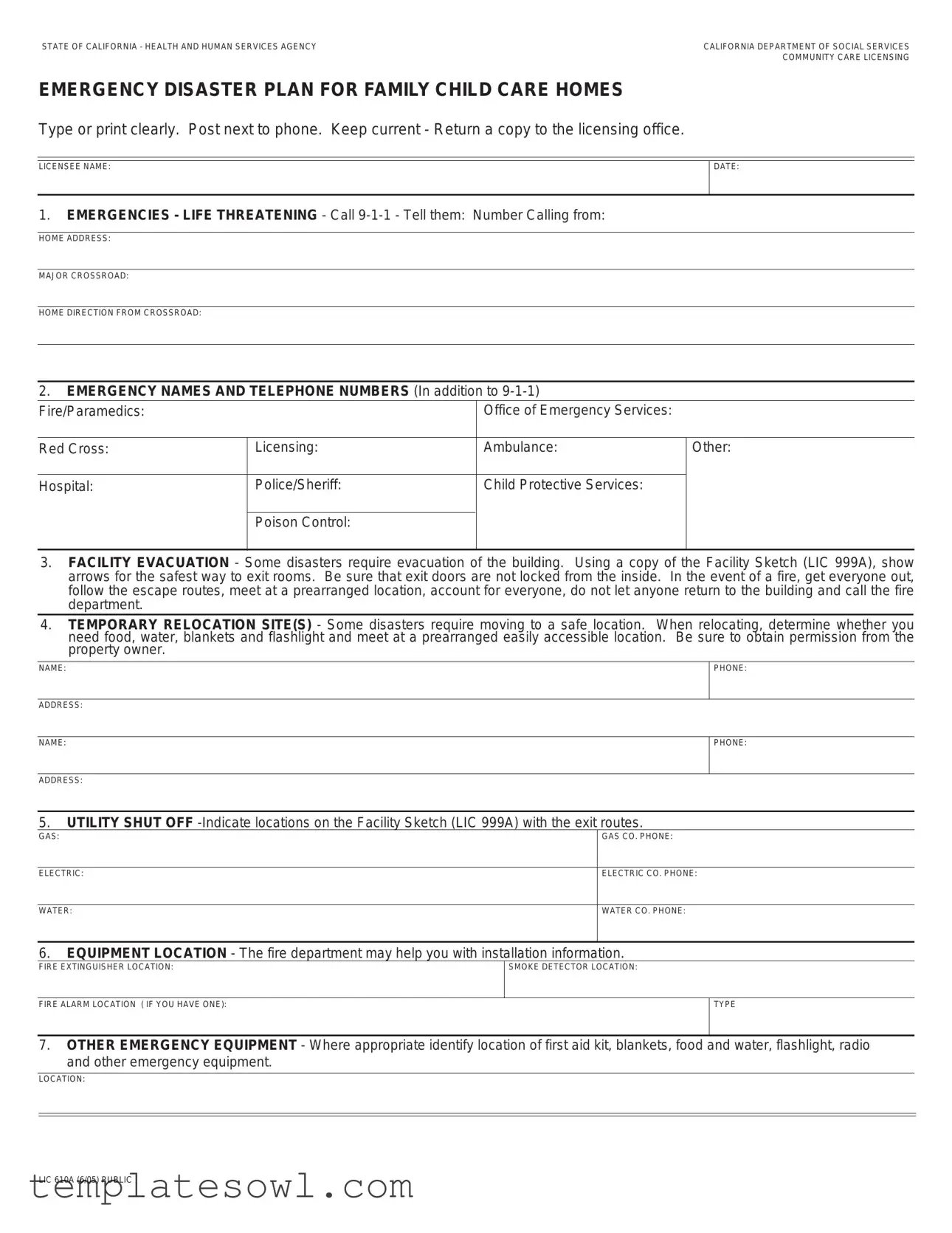STATE OF CALIFORNIA - HEALTH AND HUMAN SERVICES AGENCY |
CALIFORNIA DEPARTMENT OF SOCIAL SERVICES |
|
COMMUNITY CARE LICENSING |
EMERGENCY DISASTER PLAN FOR FAMILY CHILD CARE HOMES
Need help filling out the Emergency Disaster Plan Form?
Applicants need to submit a plan to handle possible emergencies. The Emergency Disaster Plan is a plan that identifies resources when an emergency occurs. A copy of the form must be posted in a conspicuous place near a telephone and a copy given to the licensing agency with the application packet. Licensee is responsible for updating information as required and all information should be typed or clearly handwritten.
1.EMERGENCIES - LIFE THREATENING - Whenever a life threatening emergency occurs, use the 9-1-1 telephone number. Operators are able to speed dial help for any life threatening emergency. If the call is interrupted, they are usually able to identify the home address from the open line. It is important to write out exactly what needs to be said to direct help to the home. This means that you need to write out the home phone, the address of the home, the nearest major cross street and directions to the home from the cross street.
2.EMERGENCY NAMES AND TELEPHONE NUMBERS (In addition to 9-1-1) - This is a list of additional emergency resources that you may need. Most of the numbers are listed on the form. The Office of Emergency Services (OES) assists local government and the public with emergencies that threaten lives, property and the environment. The telephone number for your local OES can be found in the white pages of the telephone book under Government Listings, County Government Offices, “Emergency Operations”. It may also be found under County Sheriff’s Department. The “Other” is extra space for other numbers that you think may be needed in an emergency.
3.FACILITY EVACUATION - The most important action in a fire emergency is getting the children safely out and grouped together in a safe location. As part of your application packet, you need to complete a facility sketch. Take a copy of the sketch and identify the quickest exiting routes from each room. Copies of the exiting routes should be posted in conspicuous locations. You also need to identify a safe location where everyone should gather to be sure everyone is counted and no one remains in the building. You need to have regular fire drills with the children. Your fire department is an excellent resource for fire and evacuation instructions.
4.TEMPORARY RELOCATION SITES - In the event of an emergency or disaster, you need to make arrangements to move to a temporary site, such as at the home of a friend or a local church. You need to identify a second site in the event the first site is not immediately available in the emergency. Be sure to get permission from the property owner of the relocation site.
5.UTILITY SHUT OFF - In emergencies such as floods and earthquakes, it may be necessary to shut the utilities off. It is important to identify the locations of the utility shut off for such emergencies. You should also have a wrench on hand for the gas line. It also may be helpful to put the utility shut off locations on the Facility Sketch.
6.EQUIPMENT LOCATION - Your home must contain a fire extinguisher and smoke detector device which meet the standards established by the State Fire Marshal. The fire extinguisher must be in a location that is easily accessible and identified in this plan. The local fire department may help you with the location of fire equipment. In addition to smoke alarms, you need to identify and locate any other emergency alarms that are on the premises. If a fire is just beginning, it may be possible to extinguish the fire with a fire extinguisher. However, the children should be safely relocated before attempting to extinguish any fire.
7.OTHER EMERGENCY EQUIPMENT - In the event of a flood or earthquake, it may be necessary to have a first aid kit, blankets, food and water, radio, flashlight and other provisions. The plan needs to identify where this other emergency equipment is kept.

